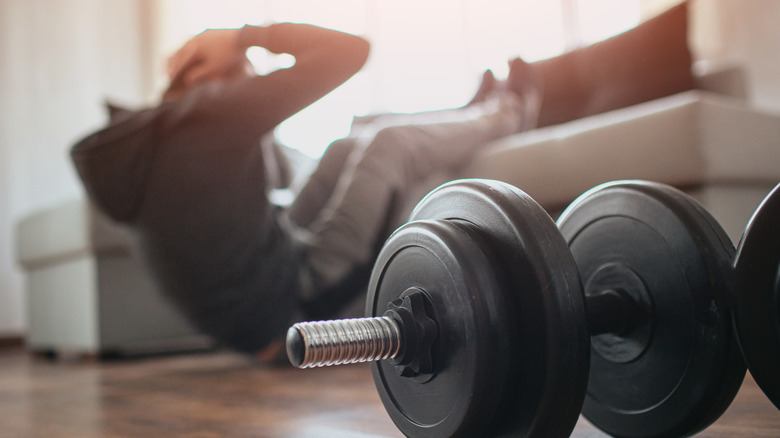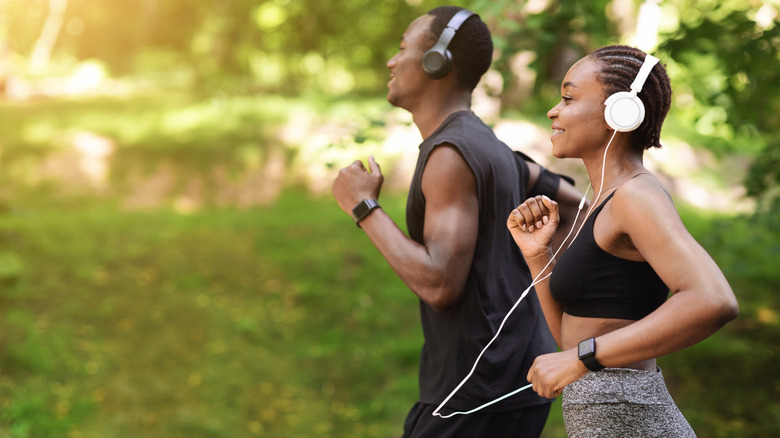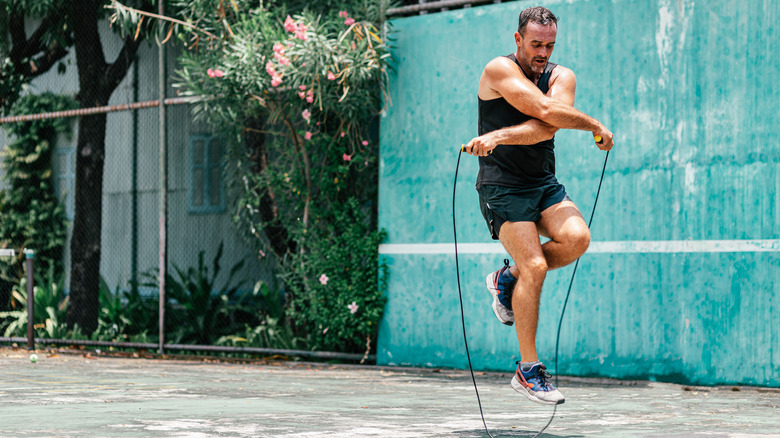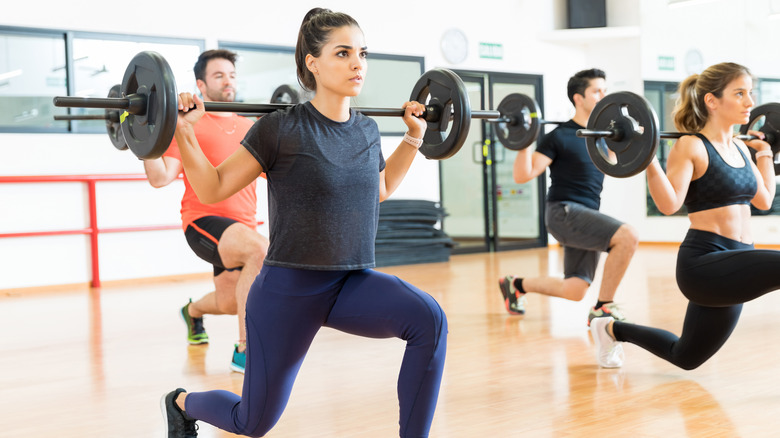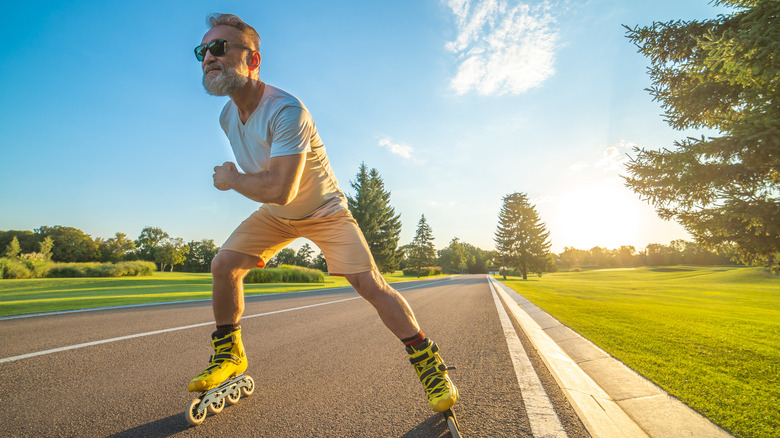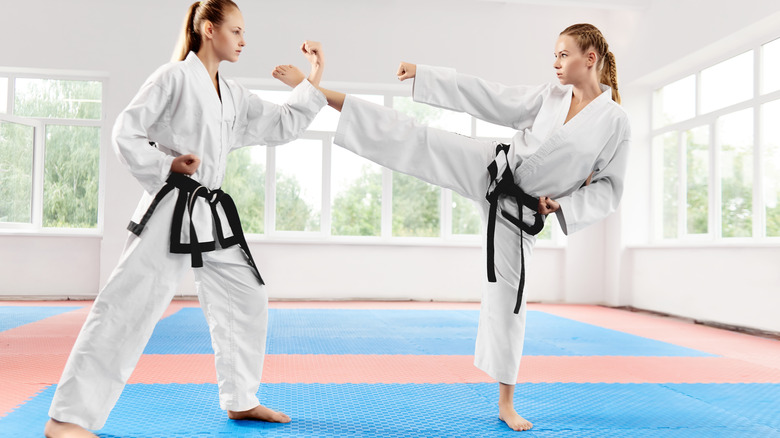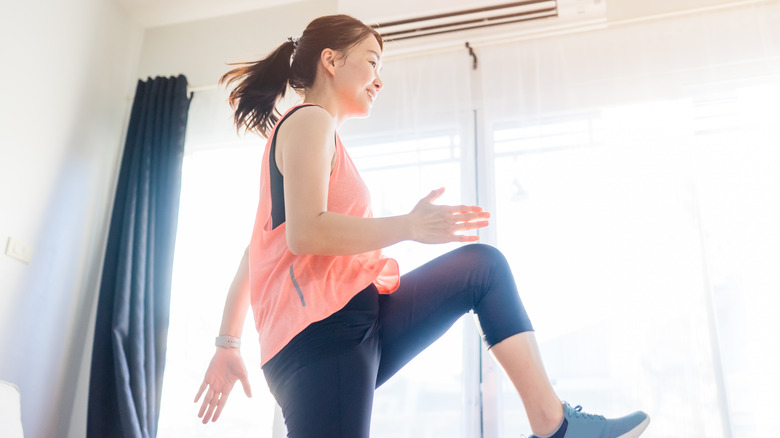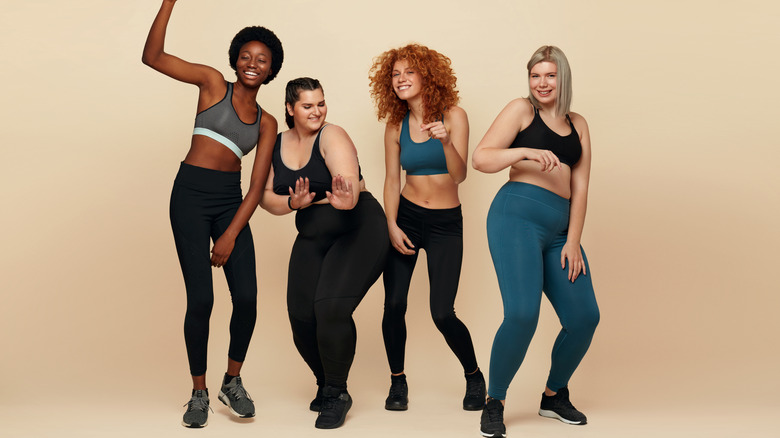Workouts That Burn The Most Calories
You've probably been told since you were a kid that physical activity is a necessity for a healthy lifestyle. Exercise keeps your heart and lungs working correctly and strengthens muscles, leading to better health overall. According to the Physical Activity Guidelines for Americans, about half of all American adults have at least one preventable chronic illness. And "seven of the ten most common chronic diseases are favorably influenced by regular physical activity," the guidelines revealed.
Working out also has another crucial responsibility: It burns calories, which our bodies need to do to help us maintain or lose weight. No matter what kind of activity you participate in, you're burning at least some calories, and any calorie burn is better than no calorie burn. However, the Centers for Disease Control and Prevention recommends at least 150 minutes of moderate or at least 75 minutes of vigorous-intensity aerobic exercise every week just to maintain your weight.
What exercises can help you reach that goal? Some workouts are definitely better than others when it comes to calorie burn. Read on to learn about some of the best calorie-burners to squeeze in each week.
Running
If you want to know what exercise can burn a ton of calories, you're looking at it. Running is one of the best calorie scorchers, burning up to 100 calories per mile, certified strength and conditioning specialist and certified sports nutritionist Tom Holland told MapMyRun. Since most adult runners can finish one mile in 10 to 13 minutes, it's possible to burn as much as 600 calories during a one-hour run.
To put things into perspective, let's compare the calorie burn of walking and running. How many calories you burn in each activity will depend on your weight, speed, metabolism, and other factors. However, running at 5 mph for one hour compared to a brisk walk at 3.5 mph for the same length of time burns about double the calories for the average person; running burns 606 calories and walking burns 314 (per Mayo Clinic).
If you're not a fan of running outside, you can get an excellent workout at home, too, simply by running in place or using a treadmill.
Circuit training
Circuit training combines both aerobics and strength training, making it an excellent full-body workout. A typical circuit training routine uses repetition with several seconds of resistance exercises followed by short resting periods. When you're done resting, you move right into the next exercise, with each one targeting different muscles. Because each aerobics and strength training burn a lot of calories on their own, you can expect to get an incredible calorie burn from circuit training.
Wayne L. Westcott, a fitness research director at a Quincy, Massachusetts YMCA, told WebMD that circuit training is so beneficial because it boosts metabolism naturally. When leaving the gym, you'll still be "burning a third more calories than [you] did in the workout — and this goes on for hours! Once you build muscle, muscle burns more calories [than fat], so you continue to burn more," explained Westcott.
Just how many calories does circuit training burn? According to information gathered by Livestrong, you can burn off between 102 to 183 calories in just 20 minutes.
Bicycling
Riding a bicycle is so much more than a childhood pastime; it can be one of the best workouts you can give your body. Not only is bicycling a good choice for people who want or need a low-impact workout, but bicycling can also improve your strength and coordination. And it can be a fun way to burn calories, especially when you join a friend or get the family involved.
According to Australia's Department of Health, bicycling can burn about 300 calories per hour, on average. Of course, you can augment its benefits further by going faster or increasing the resistance on a bike. Once you get strong enough, cycle uphill and on more challenging paths to increase its cardiovascular and strength-building benefits.
But you don't have to cycle outdoors if you don't want to. Indoor cycling can be just as productive as an outdoor romp on the roads. The thing about stationary exercise bikes is that they often include several settings, allowing you to pick the right speed and resistance for your workout. If you hop in on an intense 45-minute cycling class at the gym, you could even burn as much as 600 calories (via American Council on Exercise).
Swimming
Swimming is an intense full-body workout. When you swim, you're working the arms, legs, glutes, and core all at one time. That means you're getting your heart pumping for some cardio and building strength in all areas — and burning a lot of calories as you do it.
Physiologist and triathlete Tom Holland told Healthline, "A 150-pound person will burn roughly 400 calories during an hour-long swim at a moderate pace and 700 at a vigorous one." And when you're in the pool to cool off after a long, hot day, that hour-long swim can go by quickly and barely feel like a workout.
In addition to its notable calorie-burning benefits, swimming can do wonders for your overall health. A 2021 study published in BMC Sports Science, Medicine and Rehabilitation followed 40 participants diagnosed with type 2 diabetes. Half of the participants participated in no exercise during the study period, while the other half participated only in swimming lessons over 16 weeks. Researchers found significant improvements in body fat percentage, body mass index (BMI), blood pressure, and other variables in those who participated in swimming lessons.
Hiking
Hiking is like walking with a kick. Usually, you carry extra weight on yourself in the form of a backpack filled with supplies when you hike. And you might trek up and down steep hills and rocky surfaces. With these elements combined, you should get a better calorie burn from hiking than walking for the same amount of time, assuming that you don't stop too often to take in the scenery!
According to Harvard Health Publishing, a 155-pound person can burn 133 calories per 30-minute walk when walking at an average pace of 3.5 mph. Hiking for 30 minutes yields 216 calories for a person of the same weight.
Additionally, there are ways to get even more out of your hike to ramp up calorie burn, Franci Cohen, an exercise physiologist, told Health. One way is to slow down the pace, believe it or not. "When you go at a slower pace for a longer amount of time, your body burns more fat than carbohydrates," Cohen explained. Cohen also suggests turning your surroundings into somewhat of a gym by doing extra squats or jumping on and off tree stumps to burn more calories.
Jumping rope
Everyone remembers "Miss Mary Mack" and "Down the Mississippi" from their childhood days of jumping rope. But working out with a jump rope is far from just a kid's activity. It has loads of physical benefits. Jumping rope is a cardio exercise that raises your heart rate while strengthening and toning both the upper and lower body (per WebMD).
The American Heart Association notes that a 100-pound person can burn about 500 calories during a one-hour jump rope workout, while a 200-pound person might shed as much as 1,000 calories. That beats what you would typically lose by swimming or walking for two hours.
Want to get started jumping rope? Consider starting slowly and make sure the impact of this exercise works with your body. As Dr. Peter Schulman, physician and associate professor of cardiology and pulmonary medicine at the University of Connecticut Health Center, explained to WebMD, "You're putting direct stress on knees, ankles, and hips, but if done properly it's a lower-impact activity than jogging." Once you get some practice under your belt, you can try this calorie-incinerating jump rope workout.
Weightlifting
Weightlifting requires weights to give your muscles resistance as they work. In turn, your muscles learn to get stronger and more capable of handling intense exercises and higher weights. Plus, because muscle burns more calories than fat, the more you grow your muscles, your body will become more efficient at scorching those calories.
Weightlifting, in particular, burns even more calories than other workouts because it uses so many muscles in the body. Even for low-intensity 30-minute sessions, the average person can burn about 112 calories, while high-intensity workouts can yield closer to 223 calories (per Livestrong). When you give it your all, you could potentially burn as much as 500 calories per hour.
A 2018 study published in the International Journal of Exercise Science found that basal metabolic rate (BMR), how well your body burns calories at rest, increased in previously sedentary women after completing six weeks of resistance training with progressing intensity.
Rollerblading or roller skating
Slip on those rollerblades and head out the door for an all-body workout. According to the Mayo Clinic, a 160-pound person can expect to burn 913 calories per hour (via Livestrong). Roller skating/blading is considered a moderate activity based on intensity level, so it won't fit your needs if you're looking for a more intense exercise (via CDC). Still, it comes with lots of benefits for the body and a high calorie burn. Plus, it can make for a fun switch from your usual workout routine.
A Healthier Michigan reported that rollerblading or skating can be a good option for people needing low-impact workouts that still burn calories. You use similar muscles as you'd use when jogging or running, but because the wheels help propel your legs and body forward, you're not impacting your knees and feet. However, you still use your leg and core muscles, which can help you build strength and coordination.
Walking
Many people don't see walking as a legitimate form of exercise. But ask any doctor, and they'll likely tell you that any form of physical activity is better than none. And walking actually may burn more calories than you think. According to Healthline, a 180-pound person walking an average of 3 mph can burn approximately 270 calories in one hour. Pick up the speed of your walk to 4 mph, and that same person increases the burn to 409 calories. That's not too shabby for a long walk around the neighborhood.
Some experts even say that walking is underrated as an exercise, especially for people who can't run because of physical or health challenges. "Walking is a really good form of exercise and can help you reach your fitness and weight-loss goals," John Ford, certified exercise physiologist and owner of JKF Fitness & Health in New York City, told NBC News. "In fact, walking is the suggested workout over running for many people. For example, those with knee, ankle and back problems and also for people who are overweight to obese. Walking is a lower impact exercise and can be done for longer periods of time."
Martial arts
Martial arts include several skill forms designed to teach self-defense, like karate, judo, jujitsu, and taekwondo. The moves taught and practiced in various martial arts require a tremendous amount of body control, coordination, and strength that comes from a strong core. Each workout can lead to an excellent calorie burn, thanks to coordinated movements throughout the body. A medically-reviewed chart from the University of Rochester Medical Center gives martial arts a 720-calorie burn for a 150-pound person practicing for one hour.
Martial arts can also be good for the mind. Martial arts expert Michael Jai White explained the many benefits of martial arts in an interview with WebMD. "There are a lot of physical benefits, but to me, it's the psychological benefits that make the martial arts so special — especially the way that it teaches you to overcome obstacles. When you practice the martial arts, you get more obstacles thrown at you than life would conjure up naturally, so your mind will become well-equipped to mentally and physically face any obstacle life throws at you. Discipline, respect for others, being humble, truthful, healthy — they're all part of being a true martial artist," he said.
Aerobics
Aerobic exercises include any that target cardiovascular conditioning. In other words, they get the heart beating faster, allowing oxygen to move through the body at increased rates. That's why this type of exercise is also known as "cardio," because it's all about the heart and keeping it fit and strong. Aerobics is necessary to incorporate in your regular exercise routine to aid your body's natural processes, like regulating blood pressure, maintaining a healthy weight, and controlling blood sugar levels (per Medical News Today).
Swimming, running, and cycling are examples of aerobics. There are also more intense forms of aerobics that can increase your calorie burn, like high-intensity interval training (HIIT) and plyometrics training. Harvard Health Publishing compares the calorie burn of a few different 30-minute aerobics exercises for a 155-pound person. For example, water aerobics burns 144 calories. Depending on the intensity, too, the calorie burn may be higher or lower. Low-impact aerobics burn 198 calories, whereas high-impact aerobics burn 252 calories.
Football
Sports can be effective forms of exercise, especially when they require relatively consistent movement of your entire body, like football. According to the University of Rochester Medical Center, football can burn as many as 648 calories per hour for a 150-pound person. That's competitive football, but even a fun game of flag football can eliminate 576 calories.
That's because football is a muscle builder and fat burner, which is the perfect combination for shedding calories effectively. Football is a type of cardio activity that can simultaneously build bone strength, increase coordination, and improve cardiovascular health (per NHS Inform). A 2018 article in the British Journal of Sports Medicine refers to football as "medicine" because of its many positive impacts on health. According to the article, research has shown that participating in regular football play for at least 12 weeks can reduce fat mass, increase muscle mass, and decrease blood pressure in hypertensive patients.
Dance
Dance like nobody's watching and you just might find your body burning more calories than it does with your usual workout routine. And, admittedly, it's probably way more fun.
In fact, a 2010 article published in Home Health Care Management & Practice explained that dancing might be an easier form of exercise for some people to stick with because of how fun it can be. The article also noted several health benefits of dance, including strengthening weight-bearing bones in the legs, improving posture, increasing spatial awareness, and building a strong core to prevent lower back problems and pain. Oh — and it can burn between 200 and 500 calories per hour.
Any kind of dance will do the trick, so dance in whatever way you enjoy and can physically handle. From low-key at-home barre workouts to intense Zumba classes, you can move and groove your way to an incredible calorie burn.
Yardwork
Don't feel like you have enough time to squeeze 30 to 60 minutes of exercise into your day? Doing work around your home could be a good alternative to still burn calories and get some physical movement in. Clean the floors, organize closets, or scrub down the kitchen — they'll all get you moving around and scorching calories.
But one of the best calorie burners seems to be yard work. According to Livestrong, a 155-pound person can burn 334 calories with general gardening, 372 by digging dirt, and 446 by shoveling snow for one hour. When you have lots of yard work to do, those calories will quickly stack up to equal an excellent workout.
Other significant calorie burners include chopping wood (446 calories), mowing the lawn (334 calories), and laying sod or rock (372 calories). But even less intense tasks, like raking and planting shrubs, can burn between 298 and 334 calories. So get outside and do what you need to do. You'll burn calories no matter what.
